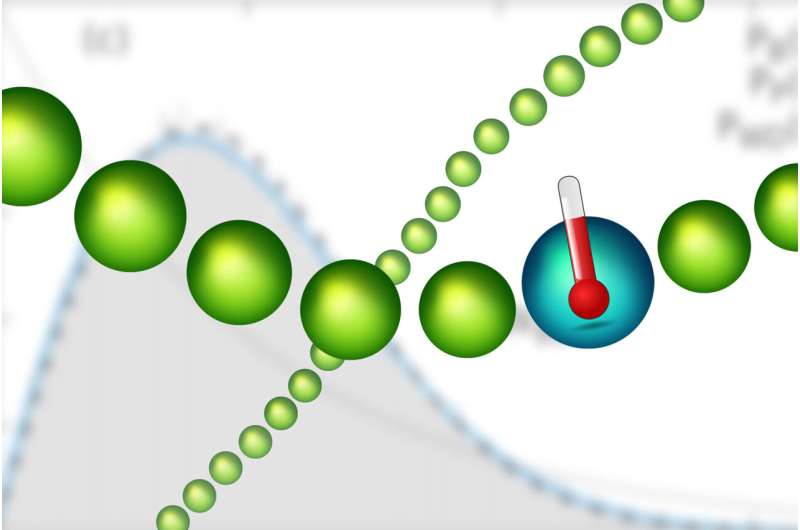
One of the particles acts as a thermometer and the whole system is simulated on the computer. Credit: TU Wien
A single particle has no temperature. It has a certain energy or a certain speed, but you can’t translate that into a temperature. Only when dealing with random velocity distributions of many particles does a well-defined temperature emerge.
How can the laws of thermodynamics derive from the laws of quantum physics? This is a topic that has attracted increasing attention in recent years. At TU Wien (Vienna), this question has now been pursued with computer simulations, which have shown that chaos plays a crucial role: only where chaos prevails, do the well-known rules of thermodynamics come from quantum physics.
Boltzmann: Anything is possible, but it can be improbable
Air molecules randomly flying around a room can assume an unimaginable number of different states: different positions and different speeds are allowed for each individual particle. But not all of these states are equally likely.
‘Physically, it would be possible to transfer all the energy in this space to a single particle, which would then move at extremely high speeds while all other particles would remain stationary,’ says Prof Iva Brezinova of the Institute for Theoretical Physics. at TU Wien. “But this is so unlikely that it will practically never be observed.”
The probabilities of several allowed states can be calculated, according to a formula that the Austrian physicist Ludwig Boltzmann established according to the rules of classical physics. And the temperature can also be read from this probability distribution: it is determined only for a large number of particles.
The whole world as a single quantum state
However, this causes problems when dealing with quantum physics. When large numbers of quantum particles are at play simultaneously, the equations of quantum theory become so complicated that even the best supercomputers in the world have no chance of solving them.
In quantum physics, individual particles cannot be considered independently of each other, as is the case with classic billiard balls. Each billiard ball has its own individual trajectory and individual position at all times. Quantum particles, on the other hand, have no individuality: they can only be described together, in one big quantum wave function.
‘In quantum physics, the whole system is described by one large many-particle quantum state,’ says Prof. Joachim Burgdörfer (TU Wien). “How a random distribution and therefore a temperature should arise from this has been a puzzle for a long time.”
Chaos theory as a mediator
A team from TU Wien has now been able to demonstrate that chaos plays a key role. To do this, the team ran a computer simulation of a quantum system made up of a large number of particles: many indistinguishable particles (the ‘heat bath’) and one of a different type of particle, the ‘sample particle’ which acts as a thermometer.
Each individual quantum wave function of the grand system has a specific energy, but no well-defined temperature, just like a single classical particle. But if you now pick the sample particle from the single quantum state and measure its velocity, you can surprisingly find a velocity distribution that corresponds to a temperature that fits the established laws of thermodynamics.
“Whether it fits or not depends on the chaos, that’s what our calculations clearly showed,” says Iva Brezinova. “We can specifically modify the interactions between particles on the computer and thus create a completely chaotic system or one that exhibits no chaos or anything in between.” And by doing so, the presence of chaos is found to determine whether or not a quantum state of the sample particle exhibits a Boltzmann temperature distribution.
“Without making any assumptions about random distributions or thermodynamic rules, thermodynamic behavior derives from quantum theory alone, if the combined system of sample particle and heat bath behaves in a quantum chaotic fashion. And one determines how well this behavior fits the well well-known Boltzmann formulas from the power of chaos”, explains Joachim Burgdörfer.
This is one of the first cases in which the interaction between three major theories has been rigorously demonstrated by many-particle computer simulations: quantum theory, thermodynamics and chaos theory.
The research is published in the journal Entropy.
More information:
Mahdi Kourehpaz et al, canonical density matrices from eigenstates of mixed systems, Entropy (2022). DOI: 10.3390/e24121740
Provided by the Vienna University of Technology
Citation: How Chaos Theory Means Between Quantum Theory and Thermodynamics (2022, Dec 14) Retrieved Dec 16, 2022 from https://phys.org/news/2022-12-chaos-theory-quantum-thermodynamics.html
This document is subject to copyright. Except in all propriety for the purpose of private study or research, no part may be reproduced without written permission. The content is provided for informational purposes only.